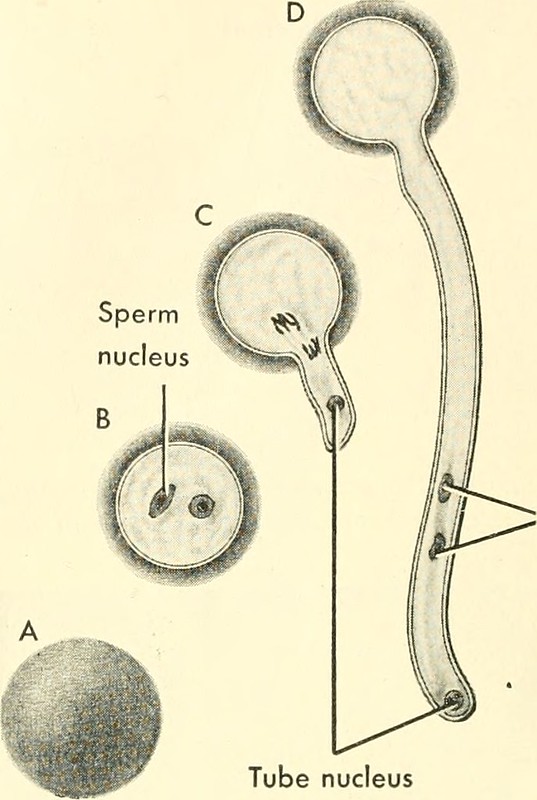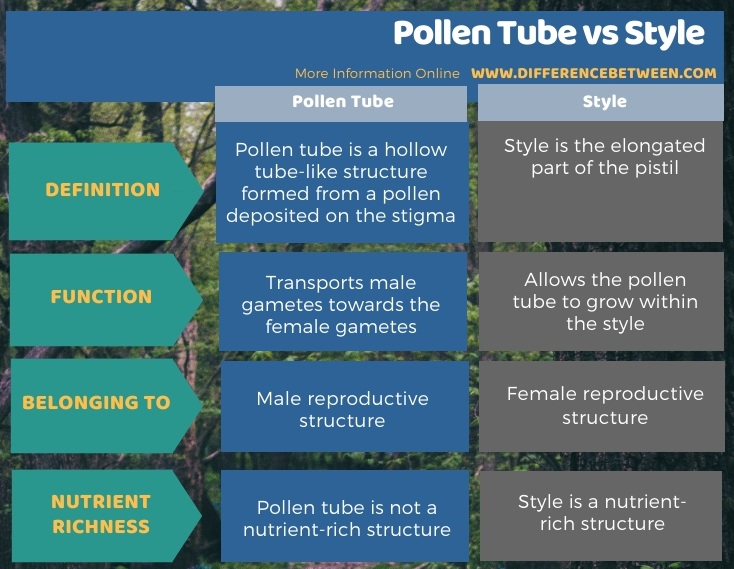The key difference between pollen tube and style is that pollen tube is a hollow tube developed from the pollen after depositing on the stigma while style is a long elongated part of the pistil that provides a path for the pollen tube to reach the ovary for syngamy.
A flower has male and female reproductive structures as stamens and pistils, respectively. The stamen consists of anthers and a filament. Meanwhile, the pistil consists of a stigma, a style and an ovary. Anthers produce pollens. Pollen grains are the male microgametophytes which carry male gametes or sperm cells. Pollens are transferred from anthers to the stigma of flowers via pollination during the sexual reproduction of flowering plants. Once pollens are deposited on the stigma of a flower, a hollow tube called pollen tube develops from the pollen. It passes through the style of the pistil carrying sperm cells towards the ovary.
CONTENTS
1. Overview and Key Difference
2. What is Pollen Tube
3. What is Style
4. Similarities Between Pollen Tube and Style
5. Side by Side Comparison – Pollen Tube vs Style in Tabular Form
6. Summary
What is Pollen Tube?
The pollen tube is a hollow tube that develops from the pollens after pollination. The development of a pollen tube takes place once pollens are implanted on the stigma of a flower. Therefore, it develops through the stigma into the style and finally into the ovary of the flower. Functionally, pollen tube acts as a conduit to transport the male gametes or sperms towards the egg cells or female gametes.

Figure 01: Pollen Tube
The development of pollen tube occurs as a response to the sugary fluid secreted by the stigma. After growing inside the ovary, pollen tube ruptures and delivers male gametes in order to carry out double fertilization in angiosperms.
What is Style?
Style is one of the three parts of female reproductive structure or pistil of a flower. It is the elongated part of the pistil which mainly acts as the stalk of the pistil. Therefore, it holds the stigma of the pistil. It also connects stigma and ovary with each other. The pollen tube grows within the style of the flower towards the ovary. In order to allow the growth of pollen tube, style is composed of soft tissues. Most importantly, style is involved with self-incompatibility reactions in order to ensure out-crossing.

Figure 02: Style
Styles are absent in some flowers such as Tulips. In such flowers, stigma directly sits on the ovary. Moreover, in some plants, style is a hollow tube similar to the pollen tube.
What are the Similarities Between Pollen Tube and Style?
- Pollen tube and style are unique to plants.
- Styles support pollen tube growth towards the ovary.
- Therefore, the pollen tube develops through the style towards the ovary.
- Both structures are important for sexual reproduction in angiosperms.
- Both style and pollen tube degenerate after fertilization.
- Moreover, both pollen tube and style are composed of vegetative cells.
What is the Difference Between Pollen Tube and Style?
The pollen tube is a hollow tube-like structure that develops from pollen. In contrast, style is a part of the pistil of a flower. So, this is the key difference between pollen tube and style. Moreover, the pollen tube transports male gametes towards the female gametes while style facilitates the growth of pollen tube within it towards the ovary. Therefore, this is the functional difference between pollen tube and style.
Besides, another difference between pollen tube and style is that style is a nutrient-rich structure while the pollen tube is not a nutrient-rich structure.

Summary – Pollen Tube vs Style
The pollen tube is a tubular protrusion from the pollen grain, which carries the sperm cells. Thus, it is a structure belonging to the male reproductive structure. Style is a part of the pistil. It is an elongate portion. Style allows pollen tube growth within it. Therefore, both the pollen tube and style are important structures in the sexual reproduction of flowering plants. Style is a nutrient-rich structure, unlike the pollen tube. This summarizes the difference between pollen tube and style.
Reference:
1.“Pollen Tube.” Wikipedia, Wikimedia Foundation, 27 Sept. 2019, Available here.
2. “Pistil.” Encyclopædia Britannica, Encyclopædia Britannica, Inc., 16 Feb. 2018, Available here.
Image Courtesy:
1. “Image from page 457 of “Adventures with animals and plants” (1948)” By Internet Archive Book Images via Flickr
2. “Parts of flower(3)” By Anjubaba – Own work (CC BY-SA 4.0) via Commons Wikimedia
ncG1vNJzZmivp6x7pbXFn5yrnZ6YsqOx07CcnqZemLyue8OinZ%2Bdopq7pLGMm5ytr5Wau268zqWjnqZdqcKjsYyapZ1lo6nGrbGO